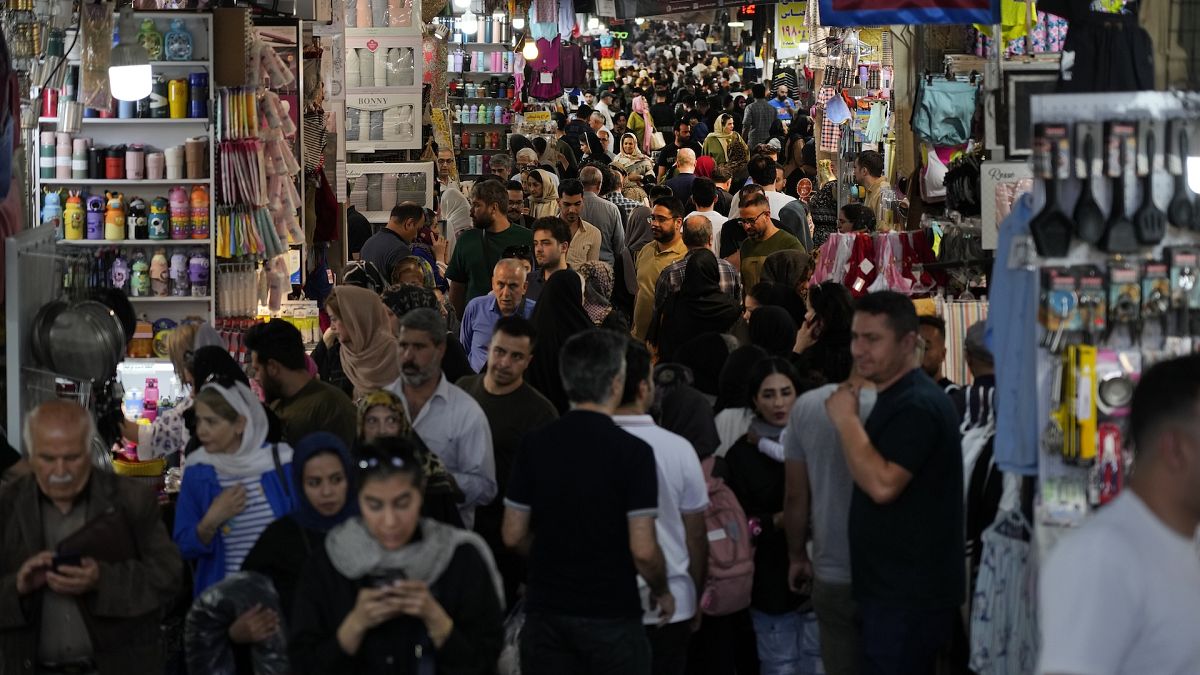Amid rising tensions in the Middle East and the threat of Israeli retaliation, Iranians are scrambling to protect their wealth by investing in gold.
The surge in demand for gold has driven up coin prices to as much as 30% above their intrinsic value with a number of factors contributing to the inflated gold coin price bubble within the Tehran market.
How trading works
Each gold coin minted by the Central Bank of Iran weighs 8.13598 grams and is made of 22-karat gold. However, each ounce of gold, which reached a historic high of $2737 (€2528) on Monday is equivalent to 31.103 grams of 24-karat gold.
Therefore, each gold coin minted by the Central Bank of Iran is equivalent to 0.2354472 ounces of 24-karat gold.
So, based on yesterday’s gold price, each gold coin is worth $644.41 (€595.28). However, in the Tehran market on Monday, it fetched up to the equivalent of $861.5 (€795), some 30% more than its daily value on the global market.
Why gold is so sought after in Iran
Apart from the global surge in gold prices, the continuous depreciation of the Iranian rial against the US dollar has caused the price of gold coins in Iran to rocket. Over the past year, the price of gold coin in rial has nearly doubled.
On Monday, the US dollar reached a new high of 650,000 rials on Tehran’s free market, while the euro was sold at 705,000 rials.
These are the highest prices since 13 April, when the dollar hit a record 670,000 rials and the euro reached 715,000 rials, just before Iran’s initial missile strike on Israel.
On 5 October, 2023, two days before Hamas’s deadly attack on Israel, the dollar was trading at 500,000 rials. By Monday, 21 October, the figure had soared to 650,000 rials.
The Iranian rial has lost about 30% of its value against the US dollar in the past year, during the tension in Gaza.
Inflation rises devaluing savings
Meanwhile, the official inflation rate in Iran stands at 35%, slightly below the average annual inflation rate over the past six years of 42%.
As a result, due to the impacts of Western economic sanctions and the inability of the government to manage the economy efficiently, Iranian people are converting their savings into valuable assets.
To reduce the demand for foreign currency, the government has declared the possession of more than 10,000 euros equivalent to be smuggling.
In addition, due to the shortage of foreign currency in the Iranian free market caused by government-imposed legal restrictions, the demand for gold coins has increased.
Demand has been further intensified because of the recession in the housing and stock markets, stemming from economic insecurity caused by the looming threat of war between Iran and Israel.
Iran’s budget deficit outlook worsens
At the same time, the government’s budget deficit outlook has also darkened.
An Iranian Ministry of Economy official recently announced that the budget deficit for the last solar year was four quadrillion rials (equivalent to $6.15bn and €5.68bn based on the free market rate and $8.16bn and €7.54bn based on the official exchange rate).
Abdolnaser Hemmati, Iran’s Minister of Economy, also said last week that the government’s budget deficit in the current solar year has reached 8.5 quadrillion rials ($13bn and €12bn based on the free market rate and $17.3bn and €15.9bn based on the official exchange rate).
Following the doubling of Iran’s government budget deficit, some economists have hypothesised that the Central Bank of Iran has resorted to selling foreign currency reserves from oil exports on the free market to finance the government’s deficit, thereby increasing the price of foreign currencies to acquire more rials.
Iran suspected of financing deficits by selling foreign currency
Although Iranian governments have consistently denied financing budget deficits through the sale of foreign currency on the free market and the devaluation of the rial, some experts have persistently levelled this accusation against the government and the Central Bank of Iran, whose independence is questioned by experts.
Therefore, not only has the certainty of further devaluation of the rial increased the demand for converting rial savings into foreign currency and gold coins, but the upward trend in exchange rates has also ensured the continued growth of gold coin prices in rial.
With the historic record of 560m rials for each full gold coin, the Central Bank of Iran announced that on Tuesday (October 22), it would hold an auction for gold coins in packages of five and would begin distributing them in nine days.
In this auction, the Central Bank of Iran allocated 3059 gold coins to participants at an average price of $835.15 and €772 based on the free-market rate and $1107 and €1023 based on the official exchange rate (542,580,000 Rials).
Thus, the Central Bank of Iran sold each gold coin, on average, $190.7 (€176.2) above its actual value, generating approximately $583,000 (€538,000) in revenue from the price bubble in one day.
Over the past eight months, the Central Bank of Iran has sold nearly 388,000 gold coins of various weights at inflated prices through auctions.

